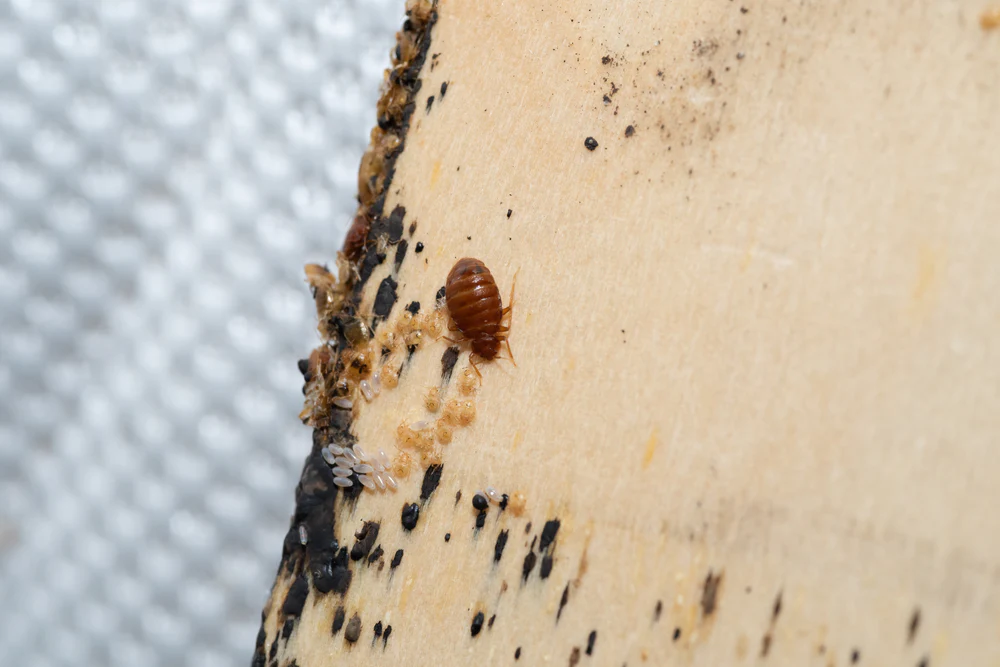Bed bugs are adept at hiding in various places within an empty house, making them challenging to detect and eliminate. Common hiding spots include mattresses, box springs, and bed frames, where they seek refuge in seams, tufts, and crevices. Upholstered furniture like sofas and chairs also provide hiding places, with bed bugs residing in seams and cushions.
Additionally, baseboards, wall hangings, and electrical outlets serve as potential hiding spots, particularly if near sleeping areas. Closets can harbor bed bugs in clothing and shoes or cracks in the walls.
Luggage left in the house may also host bed bugs, having been used in infested areas previously. Curtains, drapes, and any small cracks or crevices throughout the house are also potential hiding spots.
What are common hiding spots for bed bugs in an empty house?

Bed bugs are notorious for being excellent hiders, capable of squeezing into tiny crevices and hiding in various places within a home. In an empty house, they can be particularly difficult to find as they may spread out and hide in multiple locations. Here are some common hiding spots for bed bugs in an empty house:
Mattresses and Box Springs
Bed bugs are notorious for seeking refuge in the seams, tufts, and folds of mattresses and box springs. These areas provide dark, secluded spaces where bed bugs can hide during the day and emerge at night to feed on unsuspecting hosts.
The tight spaces and fabric material make it ideal for bed bugs to lay eggs and establish infestations unnoticed.
Bed Frames
Cracks, crevices, and joints: Bed frames, especially wooden ones, offer numerous hiding spots for bed bugs within their cracks, crevices, and joints. Bed bugs can easily squeeze into these small spaces, making detection and eradication challenging.
Additionally, bed bugs may hide in the joints where metal bed frames are welded together, further complicating efforts to eliminate them.
Upholstered Furniture
Upholstered furniture such as sofas, armchairs, and recliners provide ample hiding spots for bed bugs, particularly in the seams and cushions. Bed bugs can burrow deep into the upholstery, making them difficult to detect and eradicate.
Additionally, the frames of upholstered furniture can also harbor bed bugs, especially if they are made of wood or have fabric components.
Seams, cushions, and frames:
Within upholstered furniture, bed bugs tend to hide in the seams and cushions, as well as within the frames themselves. The seams offer narrow crevices where bed bugs can conceal themselves, while the cushions provide a comfortable hiding spot close to potential hosts.
Bed bugs may also infest the frames of upholstered furniture, especially if they are made of wood, where they can hide in cracks and crevices.
Baseboards and Molding
Baseboards and molding along walls provide hiding spots for bed bugs, particularly in the cracks and crevices where they can easily conceal themselves. Bed bugs may hide behind or underneath baseboards, making them difficult to detect without thorough inspection.
Additionally, bed bugs may infest the molding around doors and windows, further spreading the infestation throughout the house.
Wall Hangings
Wall hangings such as frames and pictures can harbor bed bugs in the spaces behind them. Bed bugs may hide behind the frames or pictures, especially if they are close to areas where humans spend time resting or sleeping.
In addition, bed bugs may infest the backing of the frames or pictures, making detection challenging without removing them from the wall for inspection.
Electrical Outlets and Switch Plates
Electrical outlets and switch plates provide small crevices where bed bugs can hide, especially if they are located near beds or other furniture. Bed bugs may squeeze into these tiny spaces, making it difficult to detect them during routine inspections.
Furthermore, bed bugs can infest the electrical wiring under outlets and switch plates, complicating efforts to eliminate them.
How to conduct a thorough inspection for bed bug hiding spots?

To find bed bugs in your home, start by checking bedrooms and places where people sleep. Look closely at mattresses, box springs, and furniture like sofas and chairs. Use a flashlight to see in dark spots. Check for tiny bugs, shed skins, and dark spots that could be their poop.
Look in cracks and crevices, like along baseboards and in closets. Inspect luggage and clothes, especially if you’ve been traveling. Put traps under furniture legs to catch bed bugs. Do this inspection a few times and take pictures if you find any bugs.
If you do find bed bugs, ask adults to help get rid of them using special methods. With careful checking and help from adults, you can keep your home free of bed bugs!
FAQ’s
How long do bed bugs stay alive?
Bed bugs can live for several months to over a year without feeding, depending on environmental conditions.
What kills bed bugs permanently?
Professional heat treatments or insecticide treatments are typically effective in killing bed bugs permanently.
What kills bed bugs?
Bed bugs can be killed using various methods, including heat treatments, insecticide sprays, vacuuming, steam cleaning, and freezing.
What kills bed bug eggs?
Bed bug eggs are typically more resistant to insecticides, so thorough heat treatments or professional-grade insecticide applications are often necessary to kill them.
What temperature kills bed bugs?
Temperatures above 120°F (49°C) are lethal to bed bugs and their eggs, making heat treatments an effective method for extermination.
Final Words
Knowing where bed bugs hide in an empty house is really important. They can hide in mattresses, furniture, and cracks in walls. To get rid of them, we need to check everywhere carefully and might need help from experts. It takes time and effort, but we can make our home bug-free again!
